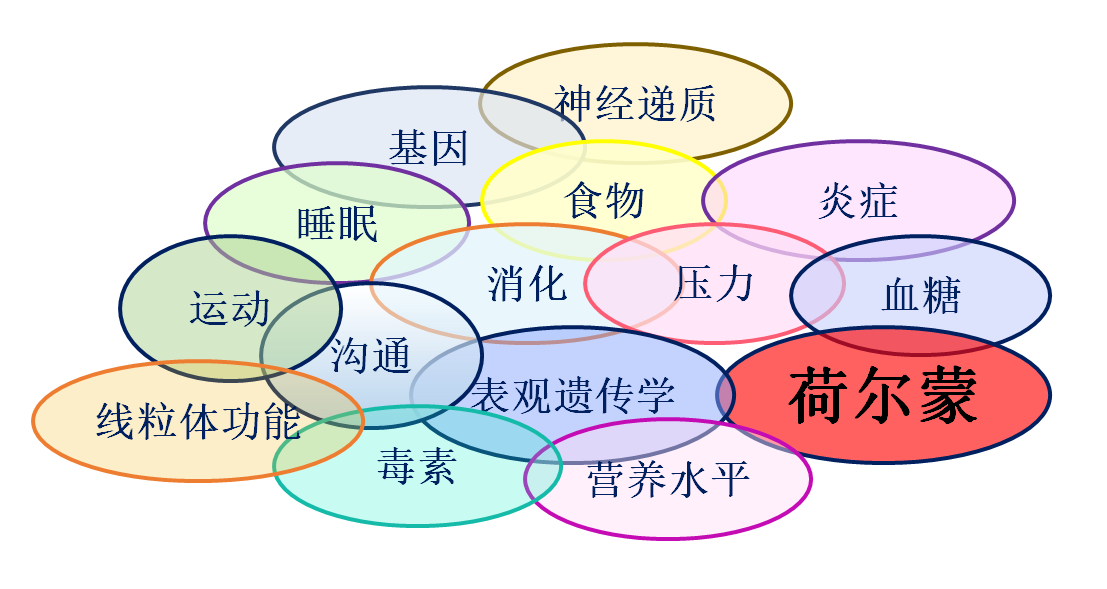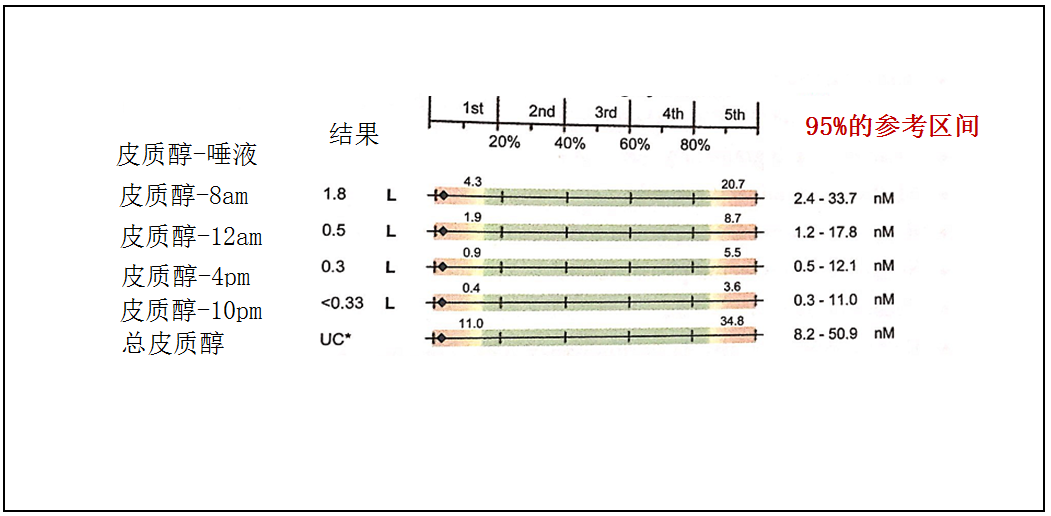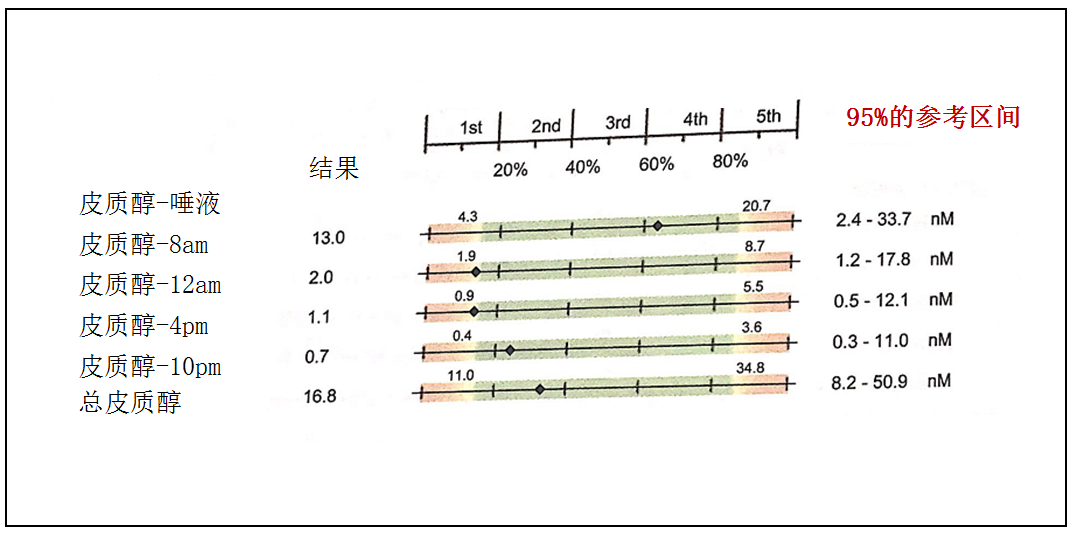编者按:现代社会疲劳、失眠、焦虑抑郁状态已经成为困扰健康的显著问题,越来越多的焦虑抑郁症患者需要引起全社会的关注。从功能医学矩阵思维模式分析,影响调节情绪的神经递质因素错综复杂。既往本平台就失眠、情绪压力等方面推送的文章《功能医学矩阵模式中的重要一环——睡眠》、《 睡眠障碍的功能医学矩阵分析及干预》和课程《失眠的功能医学分析及干预(上)——生理失衡及影响》、《失眠的功能医学分析及干预(下)——案例分析》等,受到医生和患者的欢迎。本平台应同行要求将不定期分享《功能医学与情绪系列》知识,从多视角、多维度分析与情绪相关的生理失衡,以便早期进行干预。今天就普遍存在的疲劳症状,和大家分享美国Kara Fitzgerald医生的“肾上腺疲劳”临床案例。

Adrenal Fatigue
In primary care, fatigue is a complaint in more than 20% of all patient contacts, and accounts for more than 18 million physician visits in the United States annually. In unpublished data from the US General Social Survey, at least one fatigue-associated symptom was found in 78% of all women and in 73% of all men. Many cases elude diagnosis, and patients frequently do not pursue follow-up care, although at least half of all cases demonstrate unfavorable outcomes. Adrenal fatigue (stress-induced subclinical adrenal insufficiency) is a well-recognized cause of fatigue in integrative medicine, but its diagnostic validity is challenged by the conventional medical community, who consider frank adrenal insufficiency (the most common cause being exogenous steroid withdrawals) to be the recognized clinical entity. Research, however, supports the occurrence of chronic stress-induced hypocortisolemic states. Furthermore, a remarkable 75% to 90% of all primary care visits are reported to be related to stress. Taken together, these facts suggest that adrenal fatigue may be a common cause of idiopathic fatigue.
肾上腺疲劳
在美国普通门诊的访问量每年超过1800万,其中超过百分之二十的人群有疲劳主诉。未公开的美国综合社会调查数据表明,至少有78%的女性和73%的男性有疲劳的症状。在大多数情况下,许多病例没有明确诊断,患者通常不追求后续治疗,但所有病例中至少有一半表现出不良后果。肾上腺疲劳(压力介导的亚临床型肾上腺功能不全)在整体医学中被认为是疲劳的主要原因,但是其诊断的有效性却未被传统医学界所认可,而传统医学界认为肾上腺功能不全(其最常见的原因是外源性类固醇缺乏)是一种临床阶段,但也有研究支持是慢性应激诱导低皮质醇状态的发生。此外,在所有普通门诊中多达75-90%的病人症状都与疲劳有关。综合以上,这些数据表明了肾上腺疲劳可能就是原发性疲劳最常见的原因。
CASE HISTORY
TJ was 29 years old when she presented with longstanding fatigue. She stated that the fatigue she had felt throughout college had recently worsened. The increased fatigue correlated with the completion of graduate school, which was followed by a move to a new city and the start of a new job. She described her fatigue as being worse in the evening, rating her energy level at 3 out of 10 (0 as lowest energy possible, 10 as highest energy possible). She tended to avoid late night parties, and rested most weekends. She slept well and awoke rested. TJ felt her best in the morning and used this time to maintain a regular exercise schedule of aerobic and anaerobic activities. She use some caffeine as a stimulant but tried to avoid excessive intake. She gained weight easily in her thighs, buttocks, and abdomen. Although she tended to gain it when she was feeling very stressed, she was not a binge eater. She craved salt. She occasionally had severe constipation. In spite of the fact that an elimination diet undertaken while in college revealed dairy, eggs, and soy as constipation triggers, she continued to consume forms of dairy. Her menstrual cycle was regular, with minimal PMS. She denied having had fever or myalgia. Her physical exam was unremarkable, with no fever or lymphadenopathy. Her blood pressure was low normal at 100/60 LAS.
病史
TJ ,女性,29岁,有长期疲劳症状。她说,在大学期间发现自己有疲劳症状,而且最近越来越严重,这些是和到了一座新城市,找了一份新工作以及接踵而来非常复杂的研究生院工作有关。疲劳程度在晚上尤为严重。能量水平评价仅有3 (0代表最低能量水平,10代表最高能量水平)。她尽量避免参加各种晚会,并在周末多休息,睡眠质量还算不错。她觉得自己最好的精神状态是在早晨,并充分利用这段时间有规律地做有氧和无氧运动。偶尔饮用一些咖啡,但尽量避免过多的摄入。由于她的大腿、臀部和腹部容易发胖,所以在她觉得非常疲惫而且想吃东西时,也尽量控制饮食。她喜欢偏咸的食物,经常出现便秘。她在大学期间采取了排除饮食(不含过敏性食物),避免食用乳制品、蛋类、豆制品以及容易引起便秘的食物,但坚持喝牛奶。月经周期正常,轻度经前症候群,无发热或者肌痛。身体检查未见明显异常,无发热或淋巴结肿大。血压正常(100/60mmHg)。
Laboratory tests ordered and rationale:
1.Four point-measurement of salivary cortisol: Evaluate etiology of stress-induced fatigue
2.Thyroid panel: Rule out hypothyroidism, a common cause of fatigue
3.Fasting insulin and blood sugar: Rule out dysinsulinemia, a common imbalance with fatigue and weight gain
4.Iron panel: Rule out iron deficiency, a common cause of fatigue
5.Blood chemistries: Rule out general metabolic dysfunctions, infection, macro-or microcytic anemia. All may be a cause of or associated with fatigue
实验室检查
1.四点法测量唾液皮质醇:评估应激性疲劳的病因。
2.甲状腺评估:排除甲状腺功能减退(疲劳症状的常见病因)。
3.空腹胰岛素和血糖监测:排除胰岛素异常(可引起疲劳和体重增加)。
4.铁测量:排除缺铁情况,缺铁可引起疲劳。
5.血生化:排除一般代谢功能障碍、感染、大小红细胞性贫血(都是与疲劳有关的原因)。
图1:唾液皮质醇检测结果

Initial Plan
Adrenal glandular formula (with B vitamins)
Adrenal botanical formula (Cordyceps mycelium, Panax ginseng, and Rhodiola rosea)
Vitamin C,1-3 grams/day
Multivitamin mineral formula
Re-evaluate adrenal and thyroid function in four months
Stress-reduction techniques discussed
Recommend continued exercise to tolerance
Recommend complete dairy elimination with reduction in simple carbohydrates including grains, starchy vegetables, and high-sugar fruits
Recommend minimize or discontinue coffee
Recommend fiber formula with added prune extract
初步计划
Ø 肾上腺支持配方(添加B族维生素)
Ø 肾上腺植物性配方(冬虫夏草、人参、红景天)
Ø 维生素C 1~3g/天
Ø 多种维生素矿物质配方
Ø 四个月后重新评估肾上腺和甲状腺功能
Ø 讨论如何减压
Ø 继续运动耐受练习
Ø 避免食用奶制品并减少食用碳水化合物,包括谷物、含淀粉类蔬菜和高糖水果
Ø 减少或避免饮用咖啡
Ø 建议搭配大枣萃取液和粗纤维食物一起服用
Treatment plan rationale:
Nutrient and botanical preparations associated with adrenal function were initiated. Adrenal gland extract void of active hormone has a long been used as a supportive intervention for hypoadrenalism. Cordyceps mycelium, Panax ginseng, and Rhodiola rosea have demonstrated favorable modulation of adrenal function, stress and fatigue. Vitamins C and B complex have also been shown to be helpful in normalizing adrenal function. Stress reduction techniques were taught and exercise was encouraged. It was recommended that the coffee be discontinued, because of its well-recognized potentiation of the stress response. A low glycemic, low simple carbohydrate diet was started to assist in improving insulin sensitivity. For constipation, fiber with prune extract was started and complete dietary elimination of dairy products was suggested.
治疗计划理由
与肾上腺皮质功能相关的营养素和植物性制剂在初始应用。无激素活性的肾上腺萃取物长期以来被用于肾上腺功能减退的支持性干预。冬虫夏草、人参、红景天等都具有调整肾上腺功能作用,并可以缓解压力和疲劳。维生素C和维生素B族对改善和调整肾上腺功能具有辅助功效。应教会病人如何减压,鼓励他们多做运动。建议不要饮用咖啡,因为咖啡被认为有潜在的应激反应,不利于压力的释放。另外,低血糖、低碳水化合物的食物对提高胰岛素敏感性可起到促进作用。对于便秘人群,建议应多服用含有大枣萃取液的粗纤维食物,避免食用乳制品。
Four-Month Follow-up
TJ reported that the supplements improved her energy and constipation was much better when she eliminated dairy altogether and used the fiber. She also noticed her clothes fit better. She was pleased with her progress. She noticed that one day, after having two cups of coffee, she became very tired. TJ therefore decided to eliminate coffee and switch to green tea, which did not have the same effect on her.
四个月后随访
从TJ的反馈来看,自从她不再食用乳制品,而是改为食用大量粗纤维食物之后,她觉得自己每天都能量倍增,便秘情况也有所改善,同时身材也变得苗条了,这些改变都令她非常高兴。此外,一次在她喝了两杯咖啡之后,竟然觉得更加疲惫了,所以TJ决定要远离咖啡,改喝茶,茶不会让她感到疲劳。
Four-Month Follow-up Plan
Reduce adrenal formulas
Continue other nutrients and lifestyle suggestions as directed
Re-evaluate adrenal function in six months
四个月后跟进计划
Ø 肾上腺支持配方减量
Ø 继续使用其他营养素,选择健康的生活方式
Ø 六个月后复查肾上腺功能
Ten-Month Follow-up
TJ was happy to report that she could finally be adventurous in her life, that she had
sough energy to step out and explore her new city and meet new people. Her endurance and coping ability improved. Her stress response improved. She lost 13 pounds, requiring her to buy a smaller pant size. Her GI function was good as long as she avoided her trigger foods, particularly dairy. TJ was very pleased with her progress, but noted that her fatigue would return if she didn't supplement regularly with the adrenal support products.
十个月后随访
TJ非常兴奋的说她的生活终于展开了新的一面,因为有足够的能量支持她去探索新的城市,结识新的朋友。同时,她的耐力和应对能力也有所提高,释放压力的水平也得到了相应改善。体重减轻了13磅,以后可以穿小号的裤子了。只要不吃诱发性食物尤其是乳制品,她的肠胃还是相当不错的。TJ对这些改变非常满意。但是,如果她不按时服用那些有助肾上腺功能改善的补充剂,还是会感到疲惫不堪。
图2:十个月后唾液皮质醇检测结果

Ten-Month Follow-up Plan
Continue plan
Re-evaluate thyroid and adrenal function, fasting blood sugar, and insulin in six months
十个月后跟进计划
Ø 继续按原定计划执行
Ø 六个月后复查甲状腺功能、肾上腺皮质功能、空腹血糖和胰岛素指数

